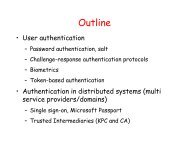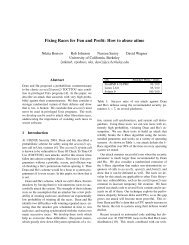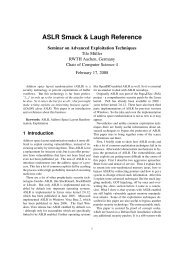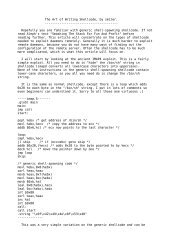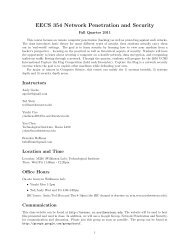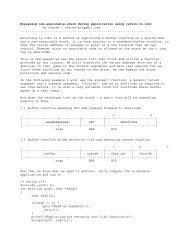Advanced Return to libc Exploits
Advanced Return to libc Exploits
Advanced Return to libc Exploits
Create successful ePaper yourself
Turn your PDF publications into a flip-book with our unique Google optimized e-Paper software.
How does it work ? The vulnerable function will return in<strong>to</strong> f1, which<br />
will see arguments f1_arg, f1_arg2 etc - OK. f1 will return in<strong>to</strong> eplg. The<br />
"addl $LOCAL_VARS_SIZE,%esp" instruction will move the stack pointer by<br />
LOCAL_VARS_SIZE, so that it will point <strong>to</strong> the place where f2 address is<br />
s<strong>to</strong>red. The "ret" instruction will return in<strong>to</strong> f2, which will see arguments<br />
f2_args. Voila. We called two functions in a row.<br />
The similar technique was shown in [5]. Instead of returning in<strong>to</strong> a<br />
standard function epilogue, one has <strong>to</strong> find the following sequence of<br />
instructions in a program (or library) image:<br />
pop-ret:<br />
popl any_register<br />
ret<br />
Such a sequence may be created as a result of a compiler optimization of a<br />
standard epilogue. It is pretty common.<br />
Now, we can construct the following payload:<br />
<br />
------------------------------------------------------------------------------<br />
| buffer fill-up | f1 | pop-ret | f1_arg | f2 | dmm | f2_arg1 | f2_arg2 ...<br />
------------------------------------------------------------------------------<br />
^<br />
|<br />
- this int32 should overwrite return address<br />
of a vulnerable function<br />
It works very similarly <strong>to</strong> the previous example. Instead of moving<br />
the stack pointer by LOCAL_VARS_SIZE, we move it by 4 bytes with the<br />
"popl any_register" instruction. Therefore, all arguments passed <strong>to</strong> f1 can<br />
occupy at most 4 bytes. If we found a sequence<br />
pop-ret2:<br />
popl any_register_1<br />
popl any_register_2<br />
ret<br />
then we could pass <strong>to</strong> f1 two arguments of 4 bytes size each.<br />
The problem with the latter technique is that it is usually<br />
impossible <strong>to</strong> find a "pop-ret" sequence with more than three pops.<br />
Therefore, from now on we will use only the previous variation.<br />
In [6] one can find similar ideas, unfortunately with some<br />
errors and chaoticly explained.<br />
Note that we can chain an arbitrary number of functions this way. Another<br />
note: observe that we do not need <strong>to</strong> know the exact location of our payload<br />
(that is, we don't need <strong>to</strong> know the exact value of the stack pointer). Of<br />
course, if any of the called functions requires a pointer as an argument,<br />
and if this pointer should point within our payload, we will need <strong>to</strong> know<br />
its location.<br />
----[ 3.3 - frame faking (see [4])




